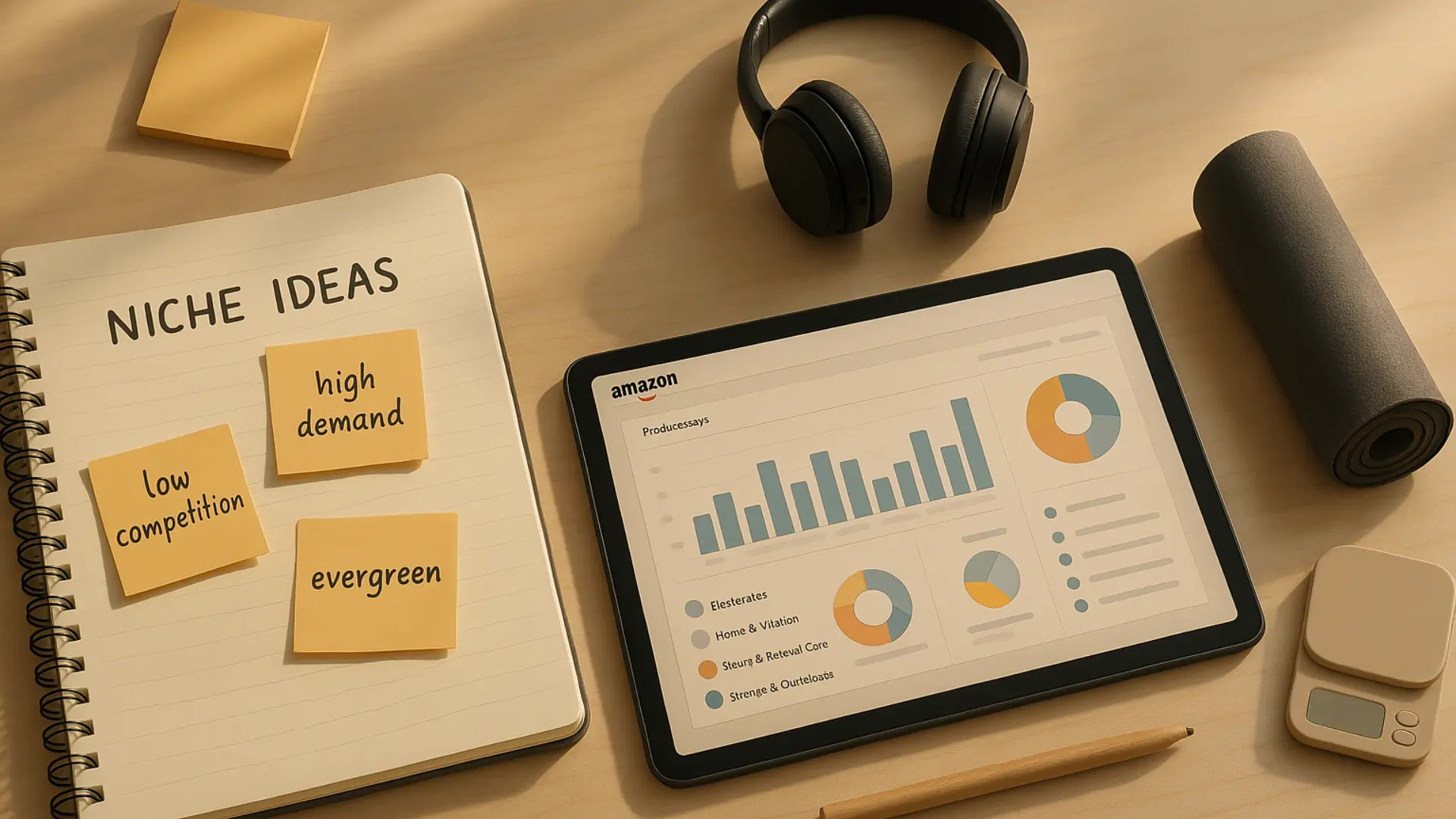How to Choose a Profitable Amazon Niche in 2025: Complete Strategy Guide

Introduction:
Identifying a profitable Amazon niche resembles striking digital gold in the digital landscape—it can transform your affiliate marketing journey from frustrating to flourishing. With over 12 million products on Amazon and fierce competition in popular categories, strategic niche selection has become more crucial than ever in 2025.
If you’ve been struggling to generate meaningful affiliate income or find yourself lost in saturated markets, you’re in the right place. This comprehensive guide will walk you through a proven, data-driven approach to identifying Amazon niches with the perfect balance of healthy demand, manageable competition, and strong profit potential.
Table of Contents
- Why Choosing a Profitable Amazon Niche Matters More Than Ever in 2025
- Essential Research Tools for Amazon Niche Selection
- Step-by-Step Process to Identify Profitable Amazon Niches
- Amazon Affiliate Commission Rate Comparison (2025)
- Micro-Niche Opportunity Analysis
- Balancing Passion and Profit: The Sustainability Factor
- Expert Insights: What Industry Leaders Are Saying
- Common Mistakes to Avoid When Choosing Your Amazon Niche
- Implementation Plan: Launching Your Profitable Amazon Niche Site (First 60 Days)
- Practical Case Study: From Research to Reality
- Advanced Techniques to Validate a Profitable Amazon Niche
- Scoring System to Compare Profitable Amazon Niche Ideas
- Diversification Strategy: Building a Portfolio of Amazon Niche Sites
- Leveraging AI Tools for More Efficient Niche Research
- Frequently Asked Questions
- Final Thoughts: The Mindset for Long-Term Success
Why Choosing a Profitable Amazon Niche Matters More Than Ever in 2025
For a step-by-step walkthrough on building niche sites, check out my detailed guide:
👉 Mastering Amazon Affiliate Niche Sites: The Ultimate Step-by-Step Blueprint (2025 Edition)
The Amazon affiliate landscape has evolved dramatically in recent years. 2020 strategies no longer deliver results in today’s competitive landscape. Amazon has adjusted commission rates, competition has intensified, and consumer behaviors have shifted significantly.
Today’s successful Amazon affiliates aren’t just picking random product categories—they’re strategically identifying profitable Amazon niches with specific characteristics:
- Underserved markets with genuine consumer needs
- Adequate search volume indicating sustainable demand
- Products with healthy profit margins (typically $50-500)
- Buyer-intent keywords that convert browsers to purchasers
- Manageable competition levels that allow new sites to rank
Let’s dive into exactly how you can find these golden opportunities in 2025.
Essential Research Tools for Amazon Niche Selection
Before we explore the strategy, let’s ensure you have the right tools in your arsenal. While some require investment, they’re essential for making informed decisions that can save you months of wasted effort.
Primary Research Tools:
- Ahrefs ($99/month) – For comprehensive keyword research and competitor analysis
- Helium 10 ($39/month) – For Amazon-specific product research and trend data
- Google Trends (Free) – For analyzing seasonal patterns and long-term interest
- Amazon Best Sellers (Free) – For identifying trending products and categories
- AnswerThePublic (Free/Paid) – For discovering questions people ask about products
Secondary Tools Worth Considering:
- SEMrush – Alternative to Ahrefs with some unique features
- Jungle Scout – Competitor to Helium 10 with robust sales estimators
- KeywordTool.io – For Amazon-specific keyword suggestions
Having at least one paid tool from the primary list is highly recommended for accurate data. However, if you’re on a tight budget, I’ll show you how to maximize the free options as well.
Step-by-Step Process to Identify Profitable Amazon Niches
🔍 Visual Overview: Here’s a quick summary of the Amazon niche selection process before we dive into each step.

Step 1: Generate Broad Niche Ideas
Start by generating broad market category ideas that match these criteria:
- Areas where you have some knowledge or interest
- Products people buy repeatedly
- Items that solve specific problems
- Products with passionate communities
- Emerging trends or technologies
For example, instead of “fitness equipment” (too broad), consider:
- Home gym equipment for small spaces
- Fitness gear for seniors
- Eco-friendly workout accessories
- Recovery tools for runners
These narrower segments make it easier to stand out in a crowded market and build authority within a profitable Amazon niche.
Step 2: Evaluate Market Demand Using Data
For each potential niche, analyze these critical metrics:
Using Ahrefs:
- Enter seed keywords related to your niche (e.g., “home gym small space”)
- Look for keywords with:
- Search volume: 1,000-10,000 monthly searches
- Keyword Difficulty: Under 40 (ideally under 30)
- High percentage of commercial keywords (buy, best, review)
With Helium 10:
- Research product categories within your niche
- Look for products with:
- Monthly sales: At least 300 units
- Average price point: $50-500 range
- Low review counts (under 500) for top sellers
Understanding search trends and keyword metrics is crucial when validating a profitable Amazon niche.
Explore Google Trends:
- Compare search interest in your niche over the past 5 years
- Identify whether interest is:
- Growing steadily (ideal)
- Stable (acceptable)
- Declining (avoid)
- Highly seasonal (plan accordingly)
Step 3: Analyze Buyer Intent and Commercial Potential
Not all traffic converts to sales. Examine these factors to assess commercial viability:
- Evaluate product price points:
- Products priced between $50-500 typically offer the best commission value
- Very cheap items (<$20) need massive volume to be profitable
- Very expensive items (>$1000) often have lower conversion rates
- Identify buyer-intent keywords:
- “Best [product] for [purpose]” (e.g., “best adjustable dumbbells for small apartments”)
- “Top [product] reviews” (e.g., “top resistance bands reviews”)
- “How to choose [product]” (e.g., “how to choose home gym equipment”)
- Check Amazon commission rates for your category:
- Sports & Outdoors: 4%
- Home & Kitchen: 3%
- Beauty & Personal Care: 3%
- Electronics: 1% (generally avoid unless high-priced)
Product pricing and buyer keywords are central to identifying a truly profitable Amazon niche.
Amazon Affiliate Commission Rate Comparison (2025)
This breakdown helps you understand which categories are more likely to support a profitable Amazon niche.
| Product Category | Commission Rate | Ideal Price Range | Profit Potential |
|---|---|---|---|
| Luxury Beauty | 10% | $50-300 | Excellent |
| Digital Music, Games, Videos | 5% | $30-100 | Good |
| Sports & Outdoors | 4% | $50-500 | Good |
| Furniture & Home Improvement | 3% | $100-1000 | Good |
| Pet Products | 3% | $30-300 | Moderate |
| Home & Kitchen | 3% | $50-500 | Moderate |
| Grocery | 1% | $20-100 | Poor |
| Electronics | 1% | $100-1000 | Poor |
| Video Games & Consoles | 1% | $50-500 | Poor |
While Amazon’s program is the most accessible for beginners, it’s not always the most profitable long-term.
If you want to explore other high-paying affiliate programs that work well alongside Amazon, check out:
👉 Best Affiliate Programs for Beginners in 2025: Start Earning Today
Profitability Analysis
Highest Profit Potential Niches:
- Luxury Beauty – High commission rate (10%) combined with strong repeat purchase patterns
- Home Fitness Equipment – Good commission rate (4%) with higher average order values
- Premium Pet Supplies – Dedicated audience with emotional purchasing decisions
Niches to Approach with Caution:
- Electronics – Despite high prices, the 1% commission rate limits profitability
- Grocery Items – Low order values combined with minimal commission rates
- Video Games – High competition and low commission rates
Strategic Recommendations:
- Focus on categories with 3%+ commission rates
- Target products priced between $50-500
- Prioritize niches with repeat purchase potential
- Consider bundling opportunities (recommending multiple products)
Step 4: How to Assess Competition for a Profitable Amazon Niche
Before committing to a niche, evaluate whether you can realistically compete:
- Analyze the top 10 Google results for your main keywords:
- Domain Authority (DA) of ranking sites
- Age of competing websites
- Content quality and depth
- Number of backlinks to ranking pages
- Look for these positive competition indicators:
- Presence of forums, Reddit threads, or Q&A sites in results
- Outdated content (older than 2 years) ranking well
- Few or no specialized affiliate sites dedicated to the niche
- Absence of major brands dominating results
- Red flags to watch for:
- Multiple established affiliate sites (5+ years old)
- Sites with 50+ DR (Domain Rating) dominating results
- Results with 100+ quality backlinks from relevant sites
Micro-Niche Opportunity Analysis
Micro-niches often present the clearest paths to building a focused, profitable Amazon niche site with long-term growth potential.
Rather than targeting broad categories, successful Amazon affiliates in 2025 are focusing on micro-niches—highly specific segments within larger markets. Here are examples to inspire your research:
Profitable Micro-Niche Examples:
| Broad Niche | Micro-Niche | Why It Works |
|---|---|---|
| Home Office | Standing Desks for Small Apartments | Specific solution to a common problem |
| Pet Supplies | Calming Products for Anxious Dogs | Emotional purchase with dedicated audience |
| Kitchen Gadgets | Specialized Coffee Equipment for Home Baristas | Passionate community with upgrade potential |
| Outdoor Gear | Ultralight Backpacking Equipment | Higher price points with enthusiast audience |
| Beauty Products | Clean Beauty for Sensitive Skin | Growing trend with repeat purchases |
Micro-Niche Evaluation Process:
- Identify specific problems within a broader category
- Find passionate communities discussing these problems
- Verify commercial intent through Amazon listings and reviews
- Check competition levels for specific long-tail keywords
- Test with sample content before fully committing
Balancing Passion and Profit: The Sustainability Factor
While profitability is crucial, sustainability comes from choosing niches that maintain your interest. Here’s how to strike the right balance:
The Passion-Profit Matrix:
Finding your sweet spot:
- High Passion + High Profit: Ideal scenario, pursue immediately
- Low Passion + High Profit: Consider outsourcing content
- High Passion + Low Profit: Potential side project or entry point
- Low Passion + Low Profit: Avoid completely

🔄 Visual Summary: This matrix helps you assess which niches are worth pursuing based on your interest and their income potential.
Remember, creating 50+ articles in a niche you find boring will likely lead to abandonment, regardless of profit potential. At minimum, choose niches where you’re curious enough to learn more.
If your chosen niche hits the sweet spot of passion and profit, you’re ready to move forward.
👉 How to Start a Blog and Make Money in 2025: A Complete Beginner’s Guide will walk you through the entire setup process.
Expert Insights: What Industry Leaders Are Saying
I reached out to several successful Amazon affiliate marketers to get their perspective on niche selection in 2025:
Spencer Haws, Founder of Niche Pursuits: “The most successful Amazon affiliates in 2025 are focusing on solving specific problems rather than just listing products. Find a niche where you can become a trusted advisor, not just a product curator.”
Doug Cunnington, Affiliate Marketing Coach: “Commission rates have changed dramatically. Today’s profitable niches require either high-ticket items or products with strong accessory and add-on potential that increase average order value.”
Gael Breton, Co-founder of Authority Hacker: “The most overlooked factor in niche selection is content scalability. Can you produce 100+ unique articles without repeating yourself? If not, the niche is likely too narrow despite good metrics.”
Common Mistakes to Avoid When Choosing Your Amazon Niche
Even with the right research tools, many new affiliates make these critical errors:
- Choosing based solely on commission rates without considering competition
- Targeting trendy products without evaluating long-term sustainability
- Selecting niches that are too broad to establish authority
- Ignoring seasonal fluctuations that can create income instability
- Focusing exclusively on best-seller lists without analyzing search intent
- Neglecting audience demographics and their purchasing behavior
- Overlooking content production requirements and your ability to create expertise-driven content
Implementation Plan: Launching Your Profitable Amazon Niche Site (First 60 Days)
Once you’ve selected a promising niche, follow this 60-day implementation plan:
Foundation Building (Days 1-15)
- Register a niche-relevant domain name
- Set up WordPress with essential plugins
- Create basic site structure and branding
- Develop detailed content plan based on keyword research
- Outline your first 10 articles
Want a full walk-through of how I launched and grew a profitable blog from scratch?
👉 How I Created a 5-Figure Passive Income Blog Using Bluehost breaks down each step with real examples and strategies.
Content Creation (Days 16-45)
- Publish 5-10 in-depth “best [product] for [specific use]” articles
- Create 3-5 informational guides addressing common questions
- Develop 2-3 product comparison posts
- Add 1-2 problem-solution content pieces
Optimization and Expansion (Days 46-60)
- Optimize all content for on-page SEO
- Begin basic link building outreach
- Analyze initial traffic and conversion data
- Adjust strategy based on early performance indicators
- Expand content plan for the next 90 days
Practical Case Study: From Research to Reality
Let’s walk through a real-world example of this niche selection process in action. This will demonstrate how the theoretical approaches we’ve discussed translate into practical decisions.
Case Study: Finding a Profitable Home Fitness Micro-Niche
Starting Point: The broad “home fitness equipment” niche
Initial Research Findings:
- Extremely competitive main keywords (KD 70+)
- Major brands and established review sites dominating SERPs
- High search volume (100K+ monthly searches)
- Good commission rate (4% in Sports category)
Despite the competition, there was clear potential to carve out a profitable Amazon niche by narrowing the focus and targeting underserved segments.
Micro-Niche Refinement Process:
- Identified specific audience segments:
- Apartment dwellers with limited space
- Seniors with mobility concerns
- Parents looking for family-friendly equipment
- Budget-conscious home gym builders
- Keyword research for the “small space fitness equipment” segment:
- “Apartment-friendly workout equipment” – 2,400 monthly searches, KD 28
- “Compact home gym for small spaces” – 3,100 monthly searches, KD 32
- “Foldable exercise equipment” – 1,800 monthly searches, KD 25
- “Space-saving fitness equipment” – 4,200 monthly searches, KD 35
- Competition analysis:
- Few dedicated sites focusing exclusively on this micro-niche
- Mostly generic fitness sites with occasional articles on the topic
- Reddit threads and forums ranking for many terms
- Content quality generally surface-level without in-depth comparisons
- Product research findings:
- Average price point: $120-350
- Multiple products can be recommended in a single article
- Strong accessory potential (mats, storage solutions, etc.)
- Year-round demand with slight January peak
Decision: This micro-niche shows strong potential with manageable competition, solid search volume, and good monetization opportunities. The site was launched with an initial focus on “fitness equipment for small apartments and condos.”
Six-month results:
- 45 published articles
- 12,000 monthly visitors
- $1,200 average monthly Amazon affiliate revenue
- Additional $500/month from other fitness affiliate programs

Advanced Techniques to Validate a Profitable Amazon Niche
These techniques help confirm whether you’re entering a sustainable and profitable Amazon niche, not just a temporary trend.
Once you’ve identified a promising micro-niche, these advanced evaluation techniques can provide additional validation before you fully commit:
1. Analyze User-Generated Content
Examine product reviews, forum discussions, and social media conversations to identify:
- Common pain points and questions
- Features users value most
- Problems with existing products
- Language patterns for content creation
Research methods:
- Amazon product Q&A sections
- Reddit subreddits related to your niche
- Facebook groups and Instagram hashtags
- Specialized forums
2. Evaluate Multiple Monetization Paths
While Amazon is your primary focus, strong niches typically offer multiple revenue streams:
- Alternative affiliate programs with higher commissions
- Digital product potential (guides, plans, templates)
- Display advertising value (RPM potential)
- Sponsorship opportunities from brands
Want to turn your niche traffic into revenue through email marketing and more?
👉 The Ultimate Guide to Monetizing Your Email List in 2025 explores multiple scalable income strategies beyond Amazon.
3. Seasonal Planning Strategy
For niches with significant seasonal fluctuations:
- Create a 12-month content calendar aligned with buying cycles
- Identify complementary products for off-peak seasons
- Plan informational content for awareness-stage seasons
- Develop an email list to maintain engagement during slow periods
4. Long-Term Trend Analysis
Beyond current demand, assess the niche’s future trajectory:
- Industry innovation and product development pipeline
- Demographic trends affecting your target audience
- Cultural shifts and their impact on purchasing behavior
- Regulatory changes that could affect products in your niche
Scoring System to Compare Profitable Amazon Niche Ideas
To objectively compare multiple potential niches, create a scoring system using these weighted factors:
| Evaluation Factor | Weight | Score (1-10) | Weighted Score |
|---|---|---|---|
| Search Volume | 15% | – | – |
| Competition Level | 20% | – | – |
| Commission Potential | 20% | – | – |
| Content Scalability | 15% | – | – |
| Personal Interest | 15% | – | – |
| Growth Trajectory | 10% | – | – |
| Seasonality | 5% | – | – |
| TOTAL SCORE | 100% | – | – |
For each potential niche, assign a score from 1-10 for each factor, multiply by the weight percentage, and calculate the total. This provides a systematic approach to comparing different opportunities.
Once you’ve validated your niche, the next step is creating content that ranks.
👉 How to Write Blog Posts That Rank #1 on Google (2025 Guide) shows you the exact structure and strategies that work in 2025.
Diversification Strategy: Building a Portfolio of Amazon Niche Sites
As you gain experience, consider developing a portfolio approach with multiple niche sites:
Strategic Portfolio Allocation:
- Core Money Site (50% effort):
- Your primary, most profitable niche
- Highest content investment
- Comprehensive coverage of the topic
- Growth Opportunity Site (30% effort):
- Emerging niche with high potential
- Moderate content investment
- First-mover advantage potential
- Experimental Site (20% effort):
- Testing ground for new niches
- Minimal initial investment
- High-risk, high-reward approach
This diversification helps protect against Amazon commission changes, algorithm updates, and market shifts while allowing you to capitalize on multiple opportunities.
Leveraging AI Tools for More Efficient Niche Research
In 2025, AI tools have become valuable assets for niche research when used strategically:
Effective AI Applications:
- Content gap analysis:
- Generate comprehensive topic lists
- Identify questions your audience is asking
- Find content angles competitors have missed
- Competitive research:
- Analyze content patterns across competing sites
- Identify keyword clusters to target
- Evaluate content quality benchmarks
- Product analysis:
- Extract common features from product listings
- Analyze review sentiment for product categories
- Identify recurring customer pain points
Important note: While AI tools accelerate research, always verify findings with manual review and apply critical thinking to the recommendations.
Frequently Asked Questions
Are Amazon niches still profitable in 2025 despite commission cuts?
Yes, Amazon niches remain profitable in 2025, but strategy has evolved. Success now requires targeting higher-priced products ($50-500), focusing on micro-niches with less competition, and diversifying with additional affiliate programs that offer better rates for the same products.
How long does it typically take to start earning from a new Amazon affiliate site?
For most new Amazon affiliate sites targeting properly researched niches, you can expect to see initial traffic at 3-4 months and meaningful revenue ($100+/month) at 6-8 months. Sites reaching $1,000+/month typically require 12-18 months of consistent effort and content development.
Should I focus on one product category or diversify across multiple related categories?
Start with a tightly focused approach in one specific product category or micro-niche. Once you’ve established authority and traffic in that area, strategically expand into closely related categories that share the same audience. This “topic cluster” approach is more effective than targeting disconnected product categories.
What’s the minimum investment needed to research and launch a profitable Amazon niche site?
To properly research and launch a competitive Amazon affiliate site in 2025, budget approximately $500-1,000 for the first six months. This includes domain registration ($15), quality hosting ($150/year), one essential research tool like Ahrefs ($99/month for 2-3 months), and potentially some starter content if you’re outsourcing ($200-500).
Is it better to create a niche site focused solely on Amazon products or a broader affiliate site?
In 2025, the most successful approach is building a niche authority site that primarily monetizes with Amazon but also incorporates other affiliate programs offering higher commission rates (8-15%) for the same products. This hybrid model provides both traffic advantages from Amazon’s wide product selection and better revenue potential from alternative programs.
Final Thoughts: The Mindset for Long-Term Success
Beyond the tactical elements we’ve discussed, developing the right mindset is crucial for Amazon affiliate success in 2025:
- Patience over immediate results:
- Expect 6-12 months before significant revenue
- Focus on content quality and user experience
- Build systems for consistent execution
- Adaptability in a changing landscape:
- Stay informed about Amazon program changes
- Regularly reassess your niche’s performance
- Be willing to pivot when necessary
- Value creation as your north star:
- Focus on genuinely helping your audience
- Create content that would be valuable even without affiliate links
- Build trust through honest, thorough recommendations
- Data-driven decision making:
- Track key performance metrics
- Test different content formats and approaches
- Let results guide your strategy
Staying consistent, choosing the right angle, and focusing on value will help you grow a long-term, profitable Amazon niche site that stands out in any market.
The most successful Amazon affiliates in 2025 aren’t just following a formula—they’re building valuable resources that serve specific audiences with unique needs. By focusing on this value-first approach, your affiliate business will be positioned to thrive regardless of commission rates or algorithm changes.








